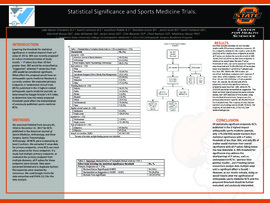| dc.contributor.author | Checketts, Jake Xavier | |
| dc.contributor.author | Johnson, Austin | |
| dc.contributor.author | Riddle, Jonathan | |
| dc.contributor.author | Evans, Sheridan | |
| dc.contributor.author | Scott, Jared | |
| dc.contributor.author | Fishbeck, Keith | |
| dc.contributor.author | Boose, Marshall | |
| dc.contributor.author | Whitener, Jake | |
| dc.contributor.author | Jones, Jaclyn | |
| dc.contributor.author | Basener, Clint | |
| dc.contributor.author | Hanson, Chad | |
| dc.contributor.author | Vassar, Matthew | |
| dc.date.accessioned | 2020-04-14T16:12:40Z | |
| dc.date.available | 2020-04-14T16:12:40Z | |
| dc.date.issued | 2019-02-22 | |
| dc.identifier | ouhd_checketts_statisticalsignificance_2019 | |
| dc.identifier.citation | Checketts, J. X., Johnson, A., Riddle, J., Evans, S., Scott, J., Fishbeck, K., Boose, M., Whitener, J., Jones, J., Basener, C., Hanson, C., & Vassar, M. (2019, Feb. 22). Statistical significance and sports medicine trials. Poster presented on Research Day at the Oklahoma State University Center for Health Sciences, Tulsa, OK. | |
| dc.identifier.uri | https://hdl.handle.net/11244/323883 | |
| dc.description.abstract | Objectives: Lowering the threshold for statistical significance in medical research from a P value of .05 to .005 was recently proposed to reduce misinterpretation of study results. What effect this proposal would have on orthopaedic sports medicine literature is currently unclear. | |
| dc.description.abstract | Research Question/Hypothesis: We seek to determine how the newly proposed threshold could affect the interpretation of previously published sports medicine RCTs. | |
| dc.description.abstract | Methods: We searched PubMed from January 01, 2016 to December 31, 2017 for RCTs published in the American Journal of Sports Medicine, Arthroscopy, and Knee Surgery, Sports Traumatology, Arthroscopy. We extracted P value data for primary endpoints, since RCTs are most often powered for these endpoints. We used Google Forms for data extraction and STATA 13.1 for the data analysis. | |
| dc.description.abstract | Results: Of the 159 studies, only 13 (8%) of the studies have endpoints in which all P values are below the new threshold of .005. 40 (25%) of the studies have endpoints in which some would meet the new P value threshold of .005, and some would not meet this new threshold. 106 (67%) of the studies have no endpoints in which the P value(s) was less than .005. Overall, 38% (59/157) of the previously statistically significant primary endpoints were less than .005, while 62% (98/157) would be reclassified as suggestive. | |
| dc.description.abstract | Conclusions: Of statistically significant endpoints in our sample, only 17% (59/350) would maintain their statistical significance with a P value threshold of less than .005, and only 8% of studies would maintain their overall significance with all P values falling below the new threshold. | |
| dc.format | application/pdf | |
| dc.language | en_US | |
| dc.publisher | Oklahoma State University Center for Health Sciences | |
| dc.rights | The author(s) retain the copyright or have the right to deposit the item giving the Oklahoma State University Library a limited, non-exclusive right to share this material in its institutional repository. Contact Digital Resources and Discovery Services at lib-dls@okstate.edu or 405-744-9161 for the permission policy on the use, reproduction or distribution of this material. | |
| dc.title | Statistical significance and sports medicine trials | |
| osu.filename | ouhd_checketts_statisticalsignificance_2019.pdf | |
| dc.type.genre | Presentation | |
| dc.type.material | Text | |
